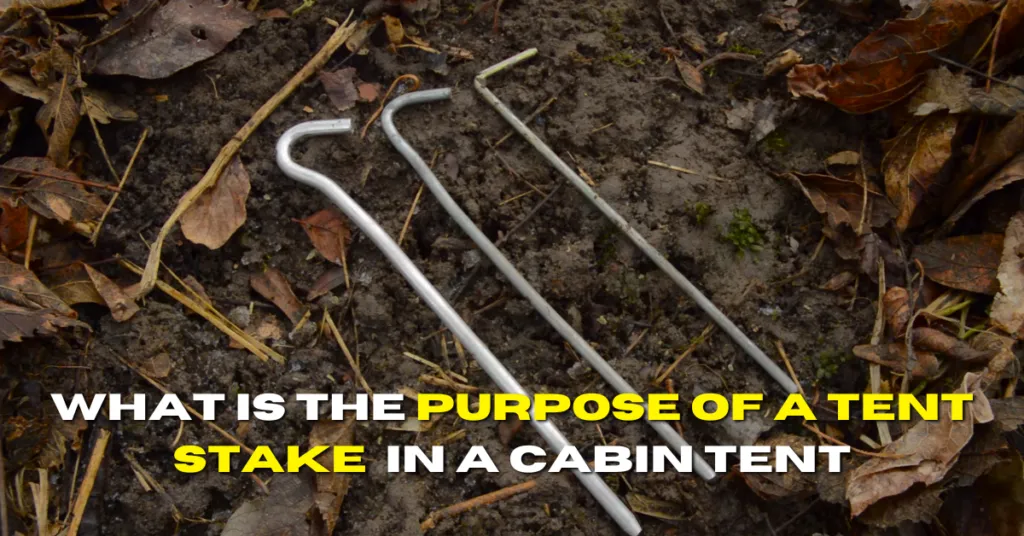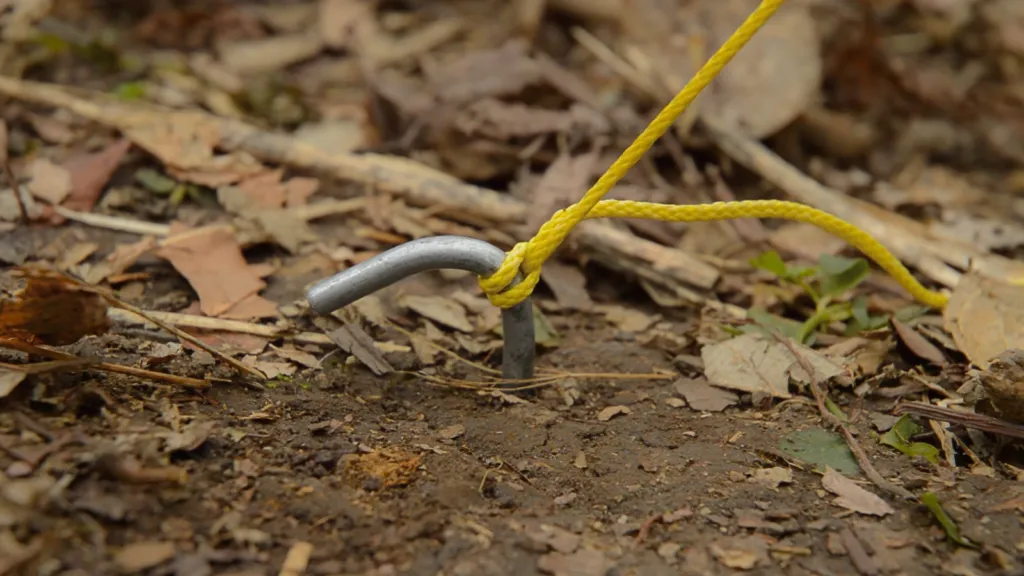
What is the Purpose of a Tent Stake in Cabin Tent? you may ask. These often-overlooked pieces of camping gear play a vital role in ensuring a stable and secure setup. Let’s explore their importance, various types, and how to use them effectively.
Table of Contents
What is the Purpose of a Tent Stake in Cabin Tent

Picture this: you’re deep in the heart of the forest as the sun begins its descent, painting the sky with hues of gold and pink. Amidst this serene backdrop, you’re getting ready to set up your cabin tent. You unpack the tent, unroll it, and suddenly realize the critical role of the unsung hero of camping gear – the tent stakes.
These stakes are your best friend when it comes to creating a secure, stable shelter in the great outdoors. They’re not just pieces of metal you hammer into the ground, they are the anchor points that hold your tent firm, providing the stability and rigidity it needs to withstand nature’s unpredictable elements.
So, let’s dive into their purpose and discover how these small but mighty tools make a huge difference in your camping experience.
Various Types of Tent Stakes and Their Specific Uses

Tent stakes are far from one-size-fits-all. They come in various shapes, sizes, and materials, each with a specific purpose in mind. Some stakes are designed for sandy or snowy terrains while others are built to tackle hard, rocky grounds. I recommend you understand these variations that can make the difference between a peaceful night under the stars or a tent flying away at the first gust of wind.
Let’s explore some of these:
- Shepherd’s Hook Stakes: These classic, curved-top stakes are made of lightweight metal, making them an excellent choice for backpackers. They’re best used on softer grounds where they can hold firm.
- V-Stakes: As the name implies, these stakes have a “V” shape offering extra hold in softer soil or grassy terrain.
- Y-Stakes: These stakes feature a three-sided design, providing additional grip, especially in loose or sandy soil. Their design is more sturdy and less likely to bend.
- Screw Stakes: These are perfect for sandy or snowy terrains. Their spiral design digs deep and holds firm where other stakes might falter.
- Nail Stakes: These heavy-duty stakes are straight, robust, and made for hard, rocky terrains where it can be challenging to drive in other stake types.
Remember, you’re in the hands of Mother Nature, and she can be unpredictable. Choosing the right stake for your terrain is a step toward a safe and enjoyable camping experience.
Material Differences
As crucial as the design is, the material of your tent stake also plays a significant role in its functionality. Tent stakes are typically made from plastic, steel, aluminum, or titanium.
Plastic stakes are lightweight and inexpensive but may not hold up well in harsh conditions. They’re best suited for light camping in good weather.
Steel stakes are heavier but extremely durable. They can take a beating, making them perfect for rocky or hard-packed grounds.
Aluminum stakes strike a balance between weight and durability. They’re lighter than steel, making them suitable for backpacking, and still quite strong.
Titanium stakes, while being the most expensive, offer the best strength-to-weight ratio. They’re durable, lightweight, and a top choice for serious campers.
Picking the right tent stake is a critical decision that can make or break your outdoor adventure. Always consider your camping terrain and weather conditions when making this choice. With the right knowledge and preparation, you’ll ensure a secure and cozy base for your nights under the starlit sky.
The Proper Use of Tent Stakes

Properly using your tent stakes is a skill every camper should master. It’s not just about jamming them into the ground. Proper installation and removal, plus good storage practices, can prolong the life of your stakes and increase the safety of your camping experience.
Stake Installation Tips
When setting up your tent, start by positioning it where you want it, keeping in mind the direction of the wind and the slope of the ground.
- Align the stakes: Align your stakes with the seams of your tent for maximum stability. This helps distribute the tension evenly across the tent material.
- Angle the stakes: Drive your stakes into the ground at about a 45-degree angle, away from the tent. This angle provides the most stability and resistance to pulling out.
- Use a mallet: If the ground is hard, use a rubber mallet to drive the stakes in. Never use rocks as they can damage your stakes.
- Check for stability: After you’ve staked down all points, give the tent a gentle shake to make sure it’s secure.
Stake Removal and Storage
When your camping trip comes to an end, removing and storing your tent stakes correctly is just as essential as installing them.
- Remove carefully: Never yank the stakes out of the ground or you risk bending or breaking them. Instead, wiggle them side to side while pulling them up gently.
- Clean and dry: Always clean off any dirt or debris and let your stakes dry before packing them away. This helps prevent rust and mold.
- Storage: Store your stakes in a separate bag or compartment from your tent to avoid ripping the tent material.
Remember, your tent stakes are an investment in your camping comfort and safety. Taking a few extra minutes for proper use and care can make a significant difference in your outdoor adventures. So next time you head out into the wild, you’ll be prepared to set up a secure and cozy shelter under the stars.
What to Do When You Can’t Use Tent Stakes
Despite their importance, there are times when you can’t use tent stakes. You might be camping on terrain where stakes can’t penetrate, or local regulations prohibit their use. Don’t fret! There are still ways to secure your tent effectively and safely.
Non-Stake Anchor Options
- Weight bags: These are specially designed bags you can fill with rocks, sand, or any other available weighty material. Attach them to your tent’s corners to keep it grounded.
- Natural anchors: Use what nature provides! You can tie your tent to nearby rocks, trees, or buried logs.
- Snow anchors: If you’re winter camping, you can use snow stakes or even make your anchors by burying items like bags filled with snow.
- Vehicle anchor: In some camping scenarios, such as on a rocky beach or a desert, your vehicle can act as a sturdy anchor.
Remember, the key is to make sure your tent is secure and stable, no matter what method you use.
Legal and Environmental Considerations
Some campsites or protected natural areas have rules against staking into the ground to preserve the landscape and prevent damage to underground utilities. Always check the local regulations before setting up your tent.
Consider practicing ‘Leave No Trace’ principles. If stakes are allowed, remember to remove them completely and fill in the holes to minimize your impact on the environment.
When you’re unable to use tent stakes, don’t let it cast a cloud over your outdoor adventure. With a bit of creativity and resourcefulness, you can still establish a secure and comfortable camp, preserving both your peace of mind and the beauty of the wilderness around you.
Conclusion
Camping is a time to reconnect with nature, create memories, and enjoy a bit of adventure. In these moments, your tent is more than just shelter—it’s your home away from home. And the humble tent stake? It’s a mighty tool that ensures your temporary dwelling stands firm and secure amidst the whims of Mother Nature.
Understanding the various types of stakes, how to use them correctly, and what to do when you can’t use them is vital for a successful camping trip. It ensures that no matter where you pitch your tent or what conditions you face, you’re prepared to create a secure, safe haven.
So, before you head out on your next trip, take a moment to appreciate these small yet crucial pieces of equipment. Choose the right type for your needs, use them properly, and always respect the environment. With this knowledge in hand, you’re ready to stake your claim to a fantastic outdoor adventure. Happy camping!
What to do Next
Now that you’re well-versed in the world of tent stakes, why not dive a little deeper into your camping knowledge? Understanding the purpose and benefits of different tent styles, like cabin tents, can truly elevate your outdoor experience.
Cabin tents, for instance, offer a unique blend of comfort and functionality that could change the way you camp. So, why not expand your horizons and dig into the fascinating world of cabin tents? A trove of insights awaits you, promising to take your camping adventures to the next level. Happy exploring, and as always, stay safe out there!
Frequently Asked Question
What is the purpose of tent stakes in a cabin tent?
Tent stakes are vital for providing stability and rigidity to your cabin tent. They anchor your tent to the ground, preventing it from shifting or getting blown away by the wind. Proper use of tent stakes can enhance your camping safety and comfort.
What different types of tent stakes are available?
Tent stakes come in various shapes and materials, each suited to different terrains. You have Shepherd’s Hook Stakes for soft ground, V-Stakes and Y-Stakes for added grip, Screw Stakes for sandy or snowy terrains, and Nail Stakes for hard, rocky grounds. The material could be plastic, steel, aluminum, or titanium, each with its own strength and weight characteristics.
How do you properly install tent stakes?
To install tent stakes properly, align them with the seams of your tent and drive them into the ground at a 45-degree angle, away from the tent. If the ground is hard, use a rubber mallet instead of a rock to avoid damaging your stakes. Always check for stability after setting them.
What alternatives can I use if I can’t use tent stakes?
If you can’t use tent stakes, you can resort to weight bags, natural anchors like rocks and trees, snow anchors, or even your vehicle to secure your tent. Always ensure your tent is secure and stable, regardless of the method you use.
How do I practice ‘Leave No Trace’ principles with tent stakes?
To practice ‘Leave No Trace’ principles, always remove your tent stakes completely and fill in the holes. This helps minimize your impact on the environment. In areas where stakes are not allowed, consider using non-stake anchor options.
